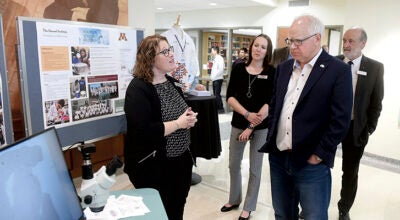Biden to meet Fed chair as inflation bites US pocketbooks
Published 6:17 pm Tuesday, May 31, 2022
|
Getting your Trinity Audio player ready...
|
WASHINGTON — President Joe Biden is set to meet with Federal Reserve Chairman Jerome Powell as soaring inflation takes a bite out of Americans’ pocketbooks and the president’s public approval.
Tuesday’s meeting is the first since Powell was renominated in November by Biden to lead the central bank and comes two weeks after his confirmation for a second term by the Senate. It also represents something of a reversal by Biden as inflation has evolved as a threat. The president asserted in April 2021 that he was “very fastidious about not talking” with the independent Fed and wanted to avoid being seen as “telling them what they should and shouldn’t do.”
The White House, along with the Fed, initially portrayed the inflation surge as a temporary side effect caused by supply chain issues as the U.S. emerged from the pandemic. Republican lawmakers were fast to criticize Biden’s $1.9 trillion coronavirus relief package from last year as pumping too much money into the economy and causing more inflation. That narrative also has held some sway with leading economists who say the financial support was excessive even though it helped the job market roar back.
Inflation has shown signs of moderating but is likely to remain far above the Fed’s 2% target through the end of this year. Gas prices are expected to keep rising, particularly now that the European Union has agreed to cut off 90% of its oil purchases from Russia. That will force the EU to buy more oil from elsewhere and drove oil prices to nearly $117 a barrel Tuesday.
This is only the fourth meeting between the president and the Federal Reserve chair, though Powell breakfasts as often as once a week with Treasury Secretary Janet Yellen.
Ahead of the meeting Biden pledged not to interfere in the Fed’s decision-making, but suggested that he and Powell are aligned on addressing inflation.
“My predecessor demeaned the Fed, and past presidents have sought to influence its decisions inappropriately during periods of elevated inflation,” Biden said in an op-ed posted Monday by The Wall Street Journal.. “I won’t do this. I have appointed highly qualified people from both parties to lead that institution. I agree with their assessment that fighting inflation is our top economic challenge right now.”
The united front between Biden and Powell is in sharp contrast to Powell’s relationship with President Donald Trump, who repeatedly attacked Powell after the Fed chair oversaw moderate interest rate hikes in 2018. Trump continued his criticism even as Powell cut rates in 2019.
Biden’s endorsement of the Fed’s policies — a stance echoed by congressional GOP leaders — gives Powell important political cover for a series of sharp interest rate hikes intended to rein in higher prices. Yet the higher rates could cause layoffs, raise the unemployment rate and even tip the economy into recession.
Amid worries that the U.S. economy may repeat the high, persistent inflation of the 1970s, the cooperation between Biden and Powell represents a crucial difference from that time and could make it easier for the Fed to restrain higher prices. In the early 1970s, President Richard Nixon pressured Fed chair Arthur Burns to lower interest rates to spur the economy before Nixon’s 1972 reelection campaign. Nixon’s interference is now widely seen as a key contributor to runaway inflation, which remained high until the early 1980s.
“That’s why comparisons to the 1970s are wrong,” said Sebastian Mallaby, a senior fellow at the Council on Foreign Relations and author of a biography on former Fed Chairman Alan Greenspan, “The Man Who Knew.” “The president’s essay was striking because he explicitly backed the Fed.”
Biden now faces an increasingly global challenge as energy and food costs jumped after Russian President Vladimir Putin ordered the invasion of Ukraine in February. Simultaneously, China imposed lockdowns tied to coronavirus outbreaks that further strained supply chains. This has left the European Union nursing record inflation and the risks of a recession, while U.S. consumers are increasingly disgruntled by gasoline prices averaging a nominal record of $4.62 a gallon.
The White House said the president and Powell would discuss the state of the U.S. and global economies. Their shared goal is to move the U.S. from its robust rebound and high inflation to low inflation and steady growth.
Consumer prices are 8.3% higher than a year ago, about four times the Fed’s target. Powell has acknowledged the U.S. central bank has limited tools to respond to supply shocks, and one of the major uncertainties is whether the Fed can bring inflation down without causing a recession in the U.S.
The administration also has few means for curbing inflation, possibly putting Biden’s political fortunes at the mercy of global markets. The president has twice ordered the release of oil from the U.S. strategic reserve, only to see a short-term and muted impact on gas prices. He’s also launched efforts to help ports clear shipping containers faster.
The administration has also proposed greater enforcement of antitrust and other laws in hopes of reducing prices for consumers, while arguing that federal deficit reduction would also help. Yet Biden’s domestic agenda faces an unclear path in Congress.
Powell has pledged to keep ratcheting up the Fed’s key short-term interest rate to cool the economy until inflation is “coming down in a clear and convincing way.” Those rate hikes have spurred fears that the Fed, in its drive to slow borrowing and spending, may push the economy into recession. That concern has caused sharp drops in stock prices in the past two months, though markets rallied last week.
Powell has signaled that the Fed will likely raise its benchmark rate by a half-point in both June and July — twice the size of the usual rate increase.
Biden, in his op-ed, indicated that the record-setting pace of job creation in the aftermath of the pandemic would slow dramatically, suggesting more moderate levels of 150,000 jobs per month from 500,000. He said, “It will be a sign that we are successfully moving into the next phase of recovery—as this kind of job growth is consistent with a low unemployment rate and a healthy economy.”





